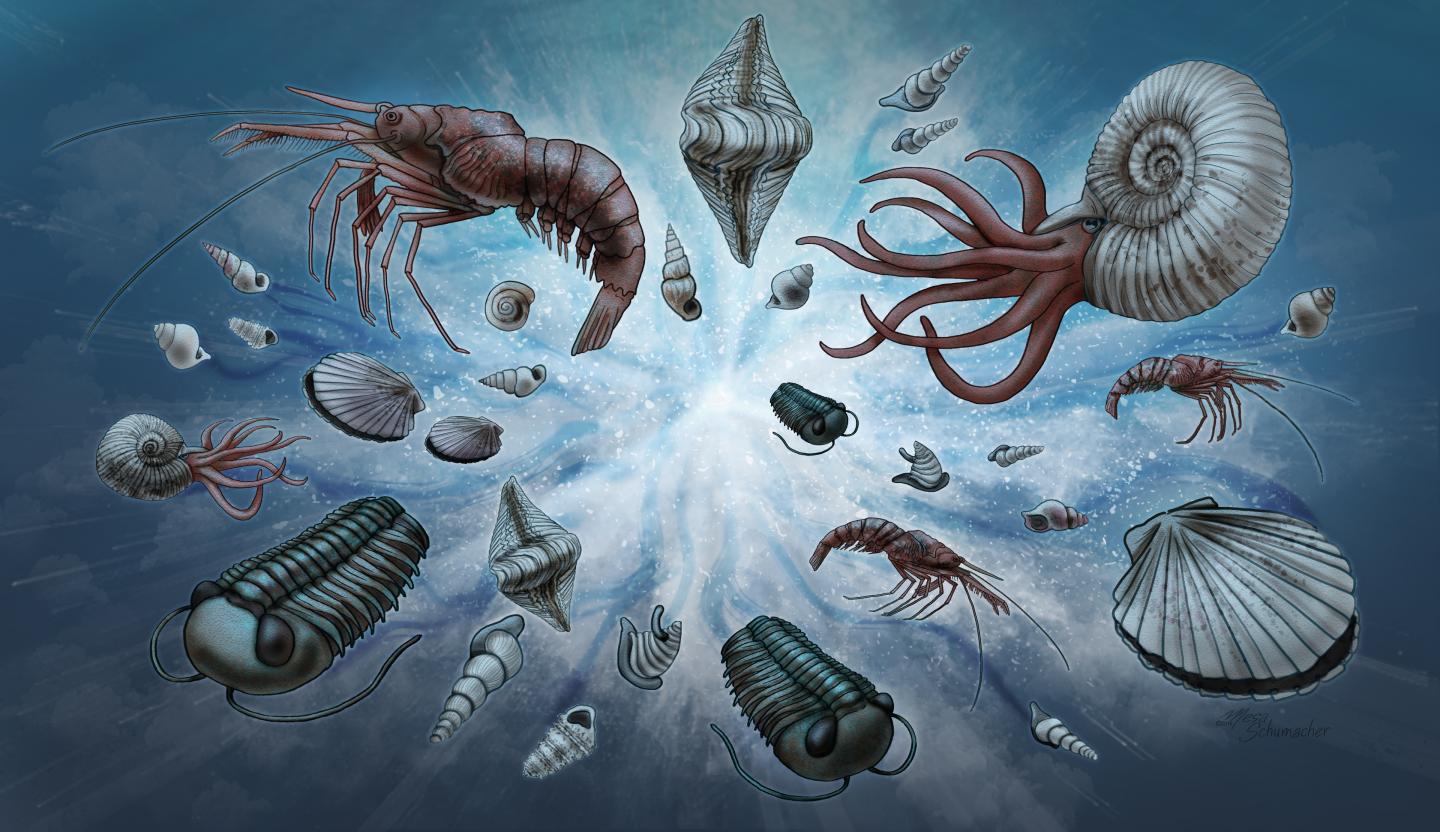Part 2 of Shanti’s new series, Humans Are Still Young. Volume 25: from the Cambrian to the Cenozoic

Credit to Mesa Shumacher, Santa Fe Institute.

Credit to Steven Earle. Licensed under Creative Commons Attribution 4.0.
The Cambrian, lovingly called ‘the springtime of life on Earth’, is bracketed between two ice-ages, one called Iceball Earth, the first mass extinction, and the other one during the next geological period, the Ordovician.
The Ordovician is famous for the colonization of the land by early land plants.
The Silurian is a remarkable time in the evolution of fishes and a foreshadow of the Devonian period.
The Devonian, ‘the age of the fish’, is the period in which plants continue to colonize the land and early tetrapods are having a good (and a predator-free) time in the food-rich environments of the new wetland ecosystems. The earliest one known to us we call Tiktaalik, the missing link between fishes and terrestrial vertebrates. Its almost complete and well-preserved fossils were found in 2004 by a team of scientists, led by Neil Shubin, on the Canadian Island Ellesmere. Near the end of the Devonian a second mass-extinction event occurs, one of the ‘Big Five’ in Earth’s history.
The Carboniferous is famous for its vast swamp forests, the source of carbon for the coal beds we, humans, are using nowadays, heating up our spaceship to most dangerous degrees. Biologically, we see in this period one of the greatest evolutionary innovations, the egg, which allows certain tetrapods a further exploitation of the land.
The Permian sees all the crustal plates of our planet together in one huge supercontinent, known as Pangea. The end of the Permian is the largest mass extinction recorded in the history of life on Earth: 90% to 95% of marine species becomes extinct, as well as 70% of all land organisms. In a blink of geological time, in as little as 100,000 years, the majority of living species on the planet are wiped out of existence.
This Great Dying affects many groups of organisms in many different environments, but it affects marine communities by far the most, causing the extinction of most of the marine invertebrates of the time. The recovery from the Permian-Triassic extinction event will take 30 million years. There is significant evidence that massive flood basalt eruptions from magma output – in what is now called the Siberian Traps – contributed to environmental stress, leading to this mass extinction. This massive eruptive event which formed the traps – one of the largest known volcanic events of the last 500 million years of Earth’s geological history – continued for a million years.
The Triassic period witnesses the appearance of new life forms, in between two major extinctions. Near the end of the Triassic the first mammals evolve. It is generally warmer in the Triassic than today, with no polar ice caps. Conifer forests begin to recover from the Permian Extinction. The new insect of the Triassic is the grasshopper, and here they are: the dinosaurs! Dinosaurs become increasingly dominant, abundant and diverse, and remain that way for the next 150 million years.
The Triassic-Jurassic boundary is similar to the Permian-Triassic boundary in that the global climate does not radically alter, though a major extinction of terrestrial vertebrates occurs.
The Jurassic is a golden age for the large herbivorous dinosaurs known as sauropods. Dinosaurs may have been the dominant land animals, but they are not alone: early mammals are mostly very small herbivores or insectivores and not in competition with the larger reptiles. The Jurassic also sees the origination of the first birds, including the well-known Archaeopteryx.
During the Cretaceous dinosaurs, both great and small, i.e. Tyrannosaurus Rex, move through the forests of ferns, cycads and conifers. Perhaps the most important event, at least for terrestrial life, is the first appearance of flowering plants. Life becomes a rainbow!
At the end of the Cretaceous Period, the Deccan Traps and other volcanic eruptions are poisoning the atmosphere. An asteroid, about ten kilometers or six miles in diameter, hits the Earth on a springtime day (thank you, Melanie During, paleontologist, for your passionate research on the season!) in the Yucatan Peninsula, Mexico, forming what is called today the Chicxulub impact crater.
It has been estimated that half of the world’s species go extinct at about this time, but no accurate species count exists for all groups of organisms.
This is the great Cretaceous–Tertiary extinction, in which the dinosaurs die out, except for the birds. But many groups of organisms, such as flowering plants, snails and clams, amphibians, lizards and snakes, crocodilians and mammals sail through the Cretaceous-Tertiary boundary, with few or no apparent extinctions at all.
The Cenozoic, meaning ‘recent life’, Earth’s current geological era, is about to begin. It represents the last 66 million years of Earth’s history and lasts till now: the last letter of the last line on the last page in the last volume.
To be continued…
Related articles on Osho News
- All articles in the series, Humans Are Still Young
- All articles in the series, At Home in the Universe





Comments are closed.